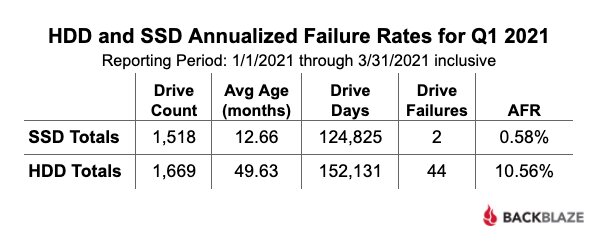The cloud storage provider Backblaze has been publishing data on the failure rates of the hard drives used in its servers for some time. The latest report also lists data from SSDs and compares them to HDDs. As expected, the SSDs fail much less often, but they are also not that old.
Cloud provider names failure rates
Backblaze has been in the cloud storage business for over 14 years and, by its own account, now offers its services to private and business customers in 175 countries and has stored more than 1 exabyte (1 million terabyte) of customer data.
For several years, Backblaze has been publishing its own statistics on the failure rates of the hard drives (HDD) used, but these are not always undisputed, as some consumer HDDs have been compared with enterprise HDDs, although the consumers -HDDs are not designed for continuous operation in the server. Nevertheless, the data provide indications of potentially critical HDD series with an increased error rate.
Backblaze compares AFR of HDDs and SSDs
In the Backblaze Drive Stats Q1 2021, in addition to the usual lists of the error rate of various HDDs, there is now also information on the SSDs that have only been used by Backblaze for around two years. These do not serve as storage for the customer data, but as boot drives for the servers. Since this means a completely different workload, Backblaze compares the annualized failure rate (AFR) of the SSDs with HDDs also used as boot data carriers.
Within the first quarter In 2021, only two of the 1,518 SSDs failed due to an error, which means an AFR of just 0.58 percent. On the other hand, there were 44 of the 1,669 HDDs, so that the annualized failure rate is a much higher 10.56 percent “>
 Failure rate (AFR) for HDD and SSD in the 1st quarter of 2021 (Image: Backblaze)
Failure rate (AFR) for HDD and SSD in the 1st quarter of 2021 (Image: Backblaze)  Failure rate (AFR) for HDD and SSD over the lifetime (Image: Backblaze)
Failure rate (AFR) for HDD and SSD over the lifetime (Image: Backblaze) When looking at the failure rate over the entire period of use, a ratio of 0.65 percent failed SSDs to 6.04 percent failed HDDs is shown. It should be noted, however, that the HDDs have a significantly higher average age of almost 50 months compared to almost 13 months for the SSDs. According to Backblaze, some HDDs have been in use for eight years, while the oldest SSDs are only 30 months. Since failure rates tend to increase with age, the comparison is not entirely fair. In the coming months, Backblaze wants to “coordinate the schedules for SSD and HDD to examine the HDD drives in the first few years of use”.
result no surprise
Regardless of age, the failure rates already confirm the long-held assumption that SSDs fail significantly less often than HDDs. This is not surprising, since both electronics and mechanics can fail with HDDs, while SSDs are free of moving parts and work purely electronically.
